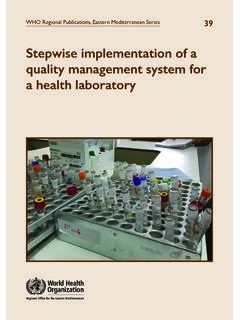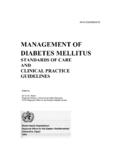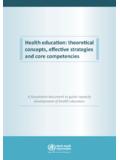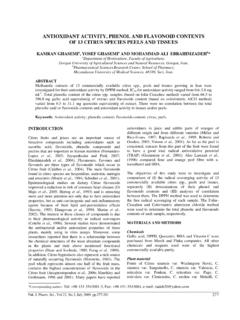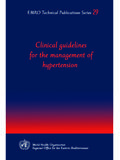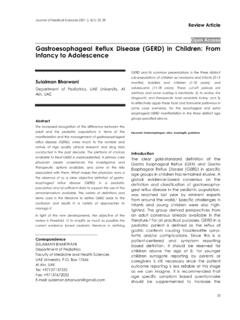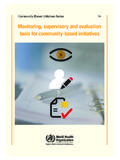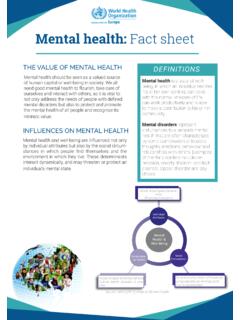Transcription of A Problem-Solving Approach - World Health Organization
1 WHO-EM/HMS/036/E Community Health Management A Problem-Solving Approach World Health Organization 2006 All rights reserved. The designations employed and the presentation of the material in this publication do not imply the expression of any opinion whatsoever on the part of the World Health Organization concerning the legal status of any country, territory, city or area or of its authorities, or concerning the delimitation of its frontiers or boundaries. Dotted lines on maps represent approximate border lines for which there may not yet be full agreement.
2 The mention of specific companies or of certain manufacturers products does not imply that they are endorsed or recommended by the World Health Organization in preference to others of a similar nature that are not mentioned. Errors and omissions excepted, the names of proprietary products are distinguished by initial capital letters. The World Health Organization does not warrant that the information contained in this publication is complete and correct and shall not be liable for any damages incurred as a result of its use. Publications of the World Health Organization can be obtained from Distribution and Sales, World Health Organization , Regional Office for the Eastern Mediterranean, PO Box 7608, Nasr City, Cairo 11371, Egypt (tel: +202 670 2535, fax: +202 670 2492; email: Requests for permission to reproduce WHO EMRO publications, in part or in whole, or to translate them whether for sale or for noncommercial distribution should be addressed to the Director, General Management, at the above address (fax: +202 276 5400.))
3 Email: WHO-EM/HMS/036/ Cover design by Ahmed Salah Mostafa Printed in Cairo, Egypt, by Grace Team 3 Contents 5 1. Introduction .. 7 2. Community Health management .. 9 Training objectives .. 9 Features of community Health management .. 9 Community Health management requirements .. 10 Community Health management training cycle .. 10 Preparation for the planning workshop .. 11 Conducting the planning workshop .. 14 Solution 15 Evaluation workshop .. 15 Expansion and 15 Role of WHO Regional Office for the Eastern 19 19 3. Planning workshop: sessions guide.
4 21 Session 1: Opening 22 Session 2: Community 23 Session 3: problem definition .. 24 Session 4: problem 28 Session 5: Field visit .. 30 Session 6: Finalization of problem definition and analysis .. 31 Session 7: Generation of ideas and solution design .. 32 Session 8: Setting objectives .. 35 Session 9: Solution implementation plan .. 37 Session 10: Monitoring and evaluation plan .. 40 Session 11: Preparation of project 43 Session 12: Presentation of teams projects .. 45 4. Planning workshop: Guiding notes for facilitators .. 46 46 Session 1: Opening session (1 h).
5 47 Session 2: Community profile (4 5 h).. 48 Session 3: problem definition (7 8 h) .. 48 Session 4: problem analysis (5 6 h).. 52 Session 5: Field visit (half day, morning) .. 53 Session 6: Finalization of problem definition and analysis (4h) .. 53 Community Health management: a Problem-Solving Approach 4 Session 7: Generation of ideas and solution design (6 h)..54 Session 8: Setting objectives (4 h) ..54 Session 9: Solution implementation plan (4 5 h) ..55 Session 10: Monitoring and evaluation plan (4 h)..56 Session 11: Preparation of the project document (one day).
6 57 Session 12: Presentation of teams projects (2 3 hours) ..57 5. Evaluation workshop: Sessions guide ..58 Session 1: Opening session ..58 Session 2: Overview of main achievements ..58 Session 3: Evaluation of activity implementation ..59 Session 4: Evaluation of solution effectiveness ..62 Session 5: Future Session 6: Assessment of 6. Evaluation workshop: Guiding notes for facilitators ..71 Session 1: Opening session (30 45 min.) ..71 Session 2: Overview of main achievements (3 h) ..71 Session 3: Evaluation of activity implementation (4 hours) ..72 Session 4: Evaluation of solution effectiveness (4 hours).
7 72 Session 5: Future plans (4 6 h)..73 Session 6: Assessment of impact (2 h)..73 Annex 1. Workshop evaluation questionnaire ..74 5 Preface While many training methodologies have succeeded in developing the management capacities of Health professionals overall, the intended impact in terms of achieving specific improvements in Health services has not been fully realized. This can be attributed to several factors. First, methodologies have tended to focus on the training of individuals. After training, individual managers return to posts where colleagues have not been trained in the same Approach .
8 They often find no useful application for their new skills and a resistance to change. Second, as most countries in the Region move towards more decentralized Health systems, the effective involvement of new decision-makers at the local level is not possible with the traditional Approach to management training. Innovative methods in management training are therefore required that are compatible with the broadened base of decision-making and the evolving roles and responsibilities of local decision-makers. Third, although the Alma-Ata Declaration on Primary Health Care strongly advocated for an intersectoral Approach and active community involvement to improve Health care and promote Health , no clear mechanism was put forward as an effective means to achieve its goals.
9 Finally, the challenges posed to the Health system from a growing population with rising expectations, the changing burden of disease, increasing resource constraints and accelerating globalization all demand new skills from Health professionals. Such realities affecting Health systems call for greater responsiveness whereby learning-by-doing, information collection and analysis, thorough planning, and monitoring and evaluation of the expected results are considered essential components within the management of Health services. In response to these challenges, WHO s Regional Office for the Eastern Mediterranean strongly advocates the use of community Health management, as a practical Approach for developing the managerial capabilities of district Health professionals.
10 Experience has shown that whenever Health care personnel are closely involved in the decision-making process, Health services improve and more confident relations develop with users and the community as a whole. In the community Health management Approach , training is organized on the basis of teams composed of staff working in the same Health unit and serving a defined community. Teams also include district supervisors and active members from the same community who could be from the municipality, local council, local non-governmental Organization and the local civil administration.


